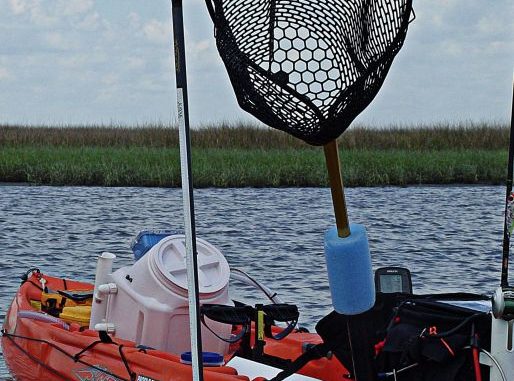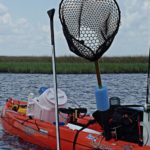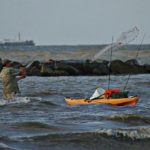
Kayak fishermen have several options for transporting live bait
For most power boats, the use of live bait is such a given that livewells almost always come as standard equipment. Many don’t think that taking live bait along in a kayak is a viable option.
However, just as kayakers have adapted the many conveniences of their powered cousins, you are as likely to find some type of live baitwell onboard as you are a depth finder or GPS.
For many fishermen, live bait is an essential. Some won’t even start their summer fishing season until live shrimp become available, which historically happens sometime in May. Recognizing the demand for live shrimp, the Louisiana Wildlife and Fisheries recently enacted a live-shrimp season that is now open year round.
In years with mild winters, as we saw in 2012-13, shrimp stay in the interior marshes and can be caught for live bait. For the first time, area fisherman found readily available supplies of live shrimp beginning in March.
If the shrimp are in the marsh to be caught, you can bet the trout and redfish will be feeding on them.
At first blush, carrying live bait in a kayak seems like a daunting task. Space is limited, and it would appear to be more trouble than it’s worth. However, with a little planning you can easily bring along enough live bait to rival the best of bay boats.
There are several types of bait containers that can be used for kayak fishing:
Commercial live wells — There are a few manufacturers that make kayak-specific livewells that consist plastic containers that sit in the rear tank-wells of kayaks. Using small 12-volt rechargeable batteries, they typically use the kayak’s “scupper” holes to recirculate water into and out of the bait tank. The batteries will last for the full trip, and the constant exchange of fresh water keeps the bait lively all day.
Home-made live wells — Using a variety of containers, do-it-yourself kayakers have assembled myriad livewells that suit their particular purposes. One of the most-popular designs uses a plastic pet food container plumbed with a small bilge pump and powered by a deer feeder-type rechargeable battery. Water is drawn in and drained through the scupper holes or a hose hanging over the side of the kayak. For the handy ’yaker, these can easily be constructed for a fraction of the cost of a commercially made model.
Portable livewells — Small buckets or containers are fitted with aeration pumps that run on batteries. These wells are filled with water, and the battery-operated air pumps typically add oxygen to the water by pumping it in through an aeration stone. While these wells are good for oxygenating the water, there is no recirculation, and the water can get hot and contaminated with waste from the bait. Periodically draining and adding new water will keep your bait alive longer. These wells can be commercially bought or easily made with readily available components.
Floating bait buckets — One of the most simplistic and inexpensive livewells is the floating bait bucket. These typically have a solid lower half that holds water when stood upright. They have a hinged door that makes it easy to get bait in and out. The upper half of the bucket is perforated to allow fresh water to exchange as the bucket is floated next to the kayak. These wells don’t cause too much drag if you’re paddling slowly while fishing. However, if you have to paddle a long distance to or between your fishing spots, it’s best to set the well inside the ’yak to eliminate the extra effort necessary to pull the well along.
Bait tubes — These inexpensive, home-made tubes are easily constructed from components available at your local hardware store. Using ABS or other foam-core drainage pipe, the tube floats alongside the kayak and constantly exchanges water through holes drilled in the ends and/or sides of the pipe. Fitted with a screw cap on one end, it’s easy to get the bait in and out of the tube. Though the tubes must be kept in the water at all times, the cylindrical shape is fairly streamlined and tows alongside the ’yak with little drag.
Although today’s modern lures are as close to the real thing as you can get, there’s still no doubt that live bait will generally out-catch artificial or dead bait. In addition to having a proper container, certain practices will keep your bait alive much longer.
Having a few lively baits is much better than having a bunch of dead ones. So don’t overcrowd your well. You’ll quickly get used to how many baits your well can support. This will obviously change with the temperature, and size and type of baits used.
If the well allows, use a small net to dip your bait. Suntan lotion, bug repellant and other contaminants on your skin can kill your bait if you use your hands for retrieval. If your well doesn’t exchange water, regularly drain and add new water to keep it clean, clear and cool.
Don’t mix bait types. Shrimp and fish don’t play well in a bait tank. Instead of having a variety of live bait, you’ll end up with a mixed bag of dead ones.
Catch or buy? Most marinas sell live bait. This is the easiest option, and you can usually choose from a variety of live, healthy baits.
However, if you want to catch your own, it’s not as hard as you think. Minnow traps can be set the night before your trip, and easily provide you with a day’s supply of fresh cocahoes.
If you want live shrimp, pulling a trawl behind your ’yak isn’t an option. However, cast-netting for live shrimp is an easy alternative. With a little practice, learning to throw a cast net is not too difficult. Small cast nets can also be carried in the kayak to refresh your supply if you run out during your fishing trip.
There’s something a little ironic about carrying live bait in a container that’s made from the same material as the kayak you’re fishing in. However, live bait can drastically increase your catch — especially when the fish want nothing else.




